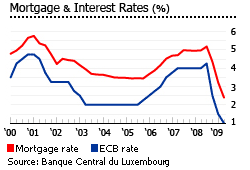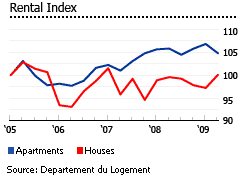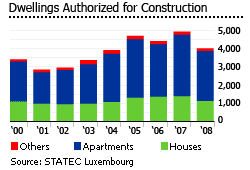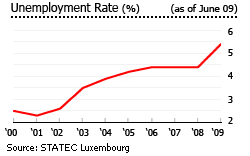House price rises continue in Luxembourg

House prices in Luxembourg have been rising since the second half of 2009, after almost two years of house price falls, with lower interest rates boosting demand.
The average apartment price rose 2.12% during the second quarter, and is 6.73% up on the same quarter last year, at €3,896 per square metre (sq. m.)., according to Observatoire de L’ Habitat. Year-on-year, prices are higher both for existing flats (6.73%) and for apartments under construction (5.27%).
House sale prices rose 4.24% (0.68% inflation-adjusted) during the year to end-Q2 2011, according to the Ministere du Logement.
Most mortgage loans in Luxembourg are variable rate, making the housing market sensitive to interest rate changes. As of September 2011, the harmonized long-term interest rate stood at 2.27%, down from 2.59% the previous month, according to the European Central Bank ( ECB).
In Q2 2011, the volume of real estate sales rose by almost €7 million, 8.5% up on the previous quarter. Demand for apartments remains strong, thanks to continued economic recovery. The economy is expected to expand by 4% in 2011.
Interest rates sharply down!

Luxembourg’s mortgage interest rates fell to an average of 2.4% in Q2 2009, in line with ECB key rate cuts, from 4.5% in Q4 2008. Most loans in Luxembourg are variable rate, rendering households very sensitive to interest rate changes. Credit conditions had tightened in early 2006, and by Q3 2008 mortgage interest rates had rose to 5.2%, from 3.7% in Q1 2006.
The average loan-to-value ratio stood at more than 85% in 2008, with around 50% of all mortgages had a loan maturity of 25 years and over.

A large mortgage market
Luxembourg’s mortgage debt as percentage of GDP has greatly increased over the last ten years, from 22% in 1999 to 40% in 2008. Mortgage market growth continued in 2008, despite the economic downturn, although at a slower pace. The value of loans for house purchases rose 7.6% in 2008, down from 22% in 2007, bringing the value of outstanding mortgage loans to €14.9 billion.

Rents unaffected by large supply increase
Average rents were relatively unchanged in Q2 2009, due to the regulated rental market despite an increase in the newly-built properties, by 91.7% in available houses for rent, and by 60% increase in available apartments for rent between Q2 2008 and Q2 2009. The enormous increase in supply of houses can possibly be explained by the preference of the residents of Luxembourg. That is, most of the residents are attracted to houses.
According to Observatoire de l´Habitat , average house rents were up 0.49% in Q2 2009 on the year, while apartment rents were down by 0.95%, . In March 2009, rental yields in Luxembourg ranged from 3.6% to 5.2%, according to Global Property Guide research, with 40 sq. m. apartments having the highest yields.

Homeownership in Luxembourg is relatively high, with 74.7% owner-occupancy, according to Banque Centrale du Luxembourg. Tenants’ rights are well protected. Most property is rented unfurnished, but for furnished properties, the rent cannot be more than double the previous rate. Rents can only be increased every three years.
Tax changes are boosting supply
With a 2,586 sq. km land area (about the size of Paris Metropolitan Area), land is scarce in Luxembourg, and the price of land available for construction significantly affects house prices.
To encourage construction, a “super-reduced” tax of 3% was introduced in 2002 on construction and renovation. The government also reduced capital gains tax on the sale of real estate, from 50% to 25%.
The total number of dwelling permits granted rose to 4,934 in 2007, from 2,956 in 2002. However, the total number of dwellings authorized in 2008 dropped to 4,017 units (1,125 houses and 2,743 apartments).

Still in recession
Luxembourg’s economy entered recession in Q4 2008 with a contraction of 3.6% q-o-q, after a 0.6% contraction in Q3 2008. The country’s economic slump continued in Q1 2009 with GDP contracting by 1.5% from the previous quarter.
The recession is expected to deepen during the rest of 2009, because the country’s financial sector, the main driver of economic growth, has been heavily affected by the global financial crisis. GDP is expected to contract by 4% in 2009, after a 0.9% contraction in 2008. Unemployment had risen to 5.4% by June 2009, up from 4.4% in 2008.
 |
 |